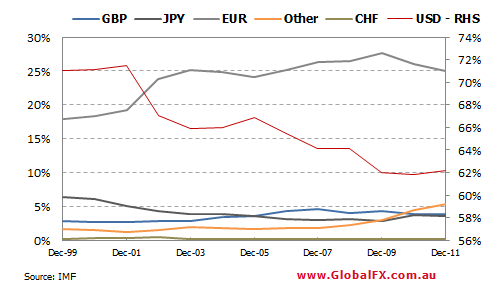It’s hard not to find a story about the Australian dollar over the past 12-18 hours without some sort of reference to the fact that the IMF is “considering” listing the Australian and Canadian dollars as reserve assets.
The media reported the news the way that the local press reports the victory of the home team in the grand final or a gold medal at the Olympics – “Aussie Aussie Aussie Oi Oi Oi” as the chant goes.
But is this really a good thing for Australia? It is a question that instantly comes to mind.
The first thing to say is that if the IMF is truly considering this move it is likely a reflection of what has already occurred with regard to the proportion of Reserve assets over the past few years as you can see in the chart below:

The chart above is the percentage of allocated reserves held in each of the major categories as reported by the IMF. The first thing to note is the steady decline of holdings denominated in US dollars of around 10 percentage points since 1999. The second thing is that Swiss francs are explicitly noted yet holdings have only been in a range of 0.41% of holdings of allocated reserves in 2002 and sat at just 0.11% at the end of 2011.
Of interest to the Australian and Canadian dollars is the orange line which is the “other” category which has clearly been on the ascendancy for a number of years now. While not explicitly reported there is a general assumption that this other is a proxy for allocated reserves held mainly in Aussie and Canadian dollars.
The reasons why reserves have been allocated to Australia and Canada are fairly straight forward when you think about the housing and economic performance of the two nations relative to the rest of the developed world but equally when you think about the composition of the respective economies and the leverage that they have due to mining and their respective terms of trade shocks you also get a sense of why they might also be benefiting.
So my belief is that when the IMF says it is considering noting the reserve status of the Aussie and Loonie and will begin to report holdings in both these currencies, it is simply following the flow of cash. But it is also a recognition of sound policy making over many years.
But as I’ve noted many times, the Australian dollar’s medium to longer term outlook is also a directly attributable to the current economic malaise gripping the developed world. I also have believed for a long time that Australia and Aussie dollar are a China proxy – insofar as it is difficult to get into the CNY and into Chinese assets in the liquid manner that funds and investors require and that once China liberalises its exchange rate regime some residual demand for the Aussie will disappear.
So it was interesting to read similar thoughts from Russell Jones of Westpac yesterday – Russell said of the move to reserve status:
AUSTRALIA AND CANADA SHOULD BE CONGRATULATED ON THEIR NEW RESERVE CURRENCY STATUS, WHICH, IN BOTH COUNTRIES WOULD HAVE PROVED IMPOSSIBLE WITHOUT AN EXTENDED PERIOD OF SOUND POLICY-MAKING. ON THE OTHER HAND, IT ALSO REFLECTS A CERTAIN AMOUNT OF LUCK IN THE SENSE THAT BOTH COUNTRIES HAVE ENJOYED LARGE POSITIVE TERMS OF TRADE SHOCKS OVER THE LAST DECADE. I WOULD FURTHER ADD THAT, AS AND WHEN THE BRICS AND OTHERS FINALLY BEGIN MORE OBVIOUSLY TO LIBERALISE THEIR DOMESTIC FINANCIAL MARKETS – AND THERE HAVE BEEN HINTS OF THIS IN CHINA OF LATE – AND THE BURGEONING GLOBAL SHORTAGE OF RISK FREE ASSETS AND STORES OF VALUE IS THEREFORE ADDRESSED, BOTH AUSTRALIA AND CANADA MAY FI ND THEMSELVES ONCE AGAIN VERY MUCH MARGINAL PLAYERS IN THE GLOBAL RESERVE ASSET GAME. BUT GIVEN THE POTENTIAL PITFALLS OF RESERVE CURRENCY STATUS, PERHAPS THIS WILL LEAVE THEIR RESPECTIVE GOVERNMENTS AND CENTRAL BANKS BREATHING SOMETHING OF A SIGH OF RELIEF.
This move is a recognition that Australia and the Australian economy remains a global economic oasis in a world of economic drought. That Australia remains well governed by the central bank and while there are risks, offshore investors on balance are less worried about them than many here at home.
But is it a good thing?
From a trading perspective it is neither good nor bad it just is and traders will trade the market in front of them – central banks and sovereigns not to mention investors every where are holding more and more Aussie and they are holding it for the longer term. At least for the moment.
Should an economic catastrophe hit us then money will flow out – but for now as China glides in for a soft landing and as the RBA continues to manage the economy gently as the slowdown in the mining boom combines with the domestic and currency induced weakness so offshore investors continue to look favourably on Australia as a place for their reserves.
Australian tourists travelling abroad or shoppers on the internet are likely to be happy with the continuation of a high AUD. But for sectors of the economy who are exposed to the strength of the Aussie dollar the news that the world is in love with the Aussie dollar and its new found reserve status is not to be cheered. With limited appetite for intervention by the Australian government or the RBA it means the AUD will likely be stronger for longer.
The Australian economy looks set to be buffeted by Aussie dollar strength with little hope of a respite unless something goes wrong in the economy or until the rest of the world’s economic woes heal. The first would be a bad outcome for everyone and the second option is yet years away.
So is Australia’s reserve status a good thing? It depends who you are and what you do.